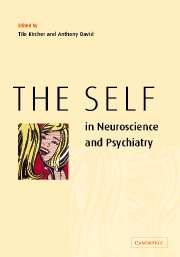Book contents
- Frontmatter
- Contents
- List of contributors
- Introduction: the self and neuroscience
- Part I Conceptual background
- Part II Cognitive and neurosciences
- 5 The multiplicity of consciousness and the emergence of the self
- 6 Asynchrony, implicational meaning and the experience of self in schizophrenia
- 7 Self-awareness, social intelligence and schizophrenia
- 8 The neural correlates of self-awareness and self-recognition
- 9 Autonoetic consciousness
- 10 The neural nature of the core SELF: implications for understanding schizophrenia
- Part III Disturbances of the self: the case of schizophrenia
- 11 Self and schizophrenia: a phenomenological perspective
- 12 Self-disturbance in schizophrenia: hyperreflexivity and diminished self-affection
- 13 The self-experience of schizophrenics
- 14 The paranoid self
- 15 Schizophrenia and the narrative self
- 16 Self-narrative in schizophrenia
- 17 Schizophrenia as disturbance of the self-construct
- 18 Action recognition in normal and schizophrenic subjects
- 19 Disorders of self-monitoring and the symptoms of schizophrenia
- 20 Hearing voices or hearing the self in disguise? Revealing the neural correlates of auditory hallucinations in schizophrenia
- 21 The cognitive neuroscience of agency in schizophrenia
- 22 Self-consciousness: an integrative approach from philosophy, psychopathology and the neurosciences
- References
19 - Disorders of self-monitoring and the symptoms of schizophrenia
from Part III - Disturbances of the self: the case of schizophrenia
Published online by Cambridge University Press: 18 December 2009
- Frontmatter
- Contents
- List of contributors
- Introduction: the self and neuroscience
- Part I Conceptual background
- Part II Cognitive and neurosciences
- 5 The multiplicity of consciousness and the emergence of the self
- 6 Asynchrony, implicational meaning and the experience of self in schizophrenia
- 7 Self-awareness, social intelligence and schizophrenia
- 8 The neural correlates of self-awareness and self-recognition
- 9 Autonoetic consciousness
- 10 The neural nature of the core SELF: implications for understanding schizophrenia
- Part III Disturbances of the self: the case of schizophrenia
- 11 Self and schizophrenia: a phenomenological perspective
- 12 Self-disturbance in schizophrenia: hyperreflexivity and diminished self-affection
- 13 The self-experience of schizophrenics
- 14 The paranoid self
- 15 Schizophrenia and the narrative self
- 16 Self-narrative in schizophrenia
- 17 Schizophrenia as disturbance of the self-construct
- 18 Action recognition in normal and schizophrenic subjects
- 19 Disorders of self-monitoring and the symptoms of schizophrenia
- 20 Hearing voices or hearing the self in disguise? Revealing the neural correlates of auditory hallucinations in schizophrenia
- 21 The cognitive neuroscience of agency in schizophrenia
- 22 Self-consciousness: an integrative approach from philosophy, psychopathology and the neurosciences
- References
Summary
Abstract
In this chapter we attempt to explain one class of symptoms associated with schizophrenia. We concentrate on symptoms that are characterized by a confusion between the self and other, such as auditory hallucinations and delusions of control. We propose that such symptoms arise because of a failure in the mechanism by which the predicted consequences of self-produced actions are derived from an internal forward model. Normally the forward model predicts and cancels the sensory consequences of self-produced actions. We argue that an impairment in this prediction and cancellation mechanism can cause self-produced sensations to be classified as externally produced. This problem leads to a number of behavioural consequences, such as a lack of central error correction, many of which have been observed in patients with delusions of control and related symptoms. At the physiological level, delusions of control are associated with overactivity in the parietal cortex. We suggest that this overactivity results from a failure to attenuate responses to sensations of limb movements even though these sensations can be anticipated on the basis of the movements intended. The lack of attenuation may arise from corticocortical disconnections which prevent inhibitory signals arising in the frontal areas which generate motor commands from reaching the appropriate sensory areas.
Introduction
Auditory hallucinations and passivity symptoms in schizophrenia
Rather than attempting to elucidate a biological basis for schizophrenia, our aim in this chapter is to try and explain one class of symptoms.
- Type
- Chapter
- Information
- The Self in Neuroscience and Psychiatry , pp. 407 - 424Publisher: Cambridge University PressPrint publication year: 2003
References
- 7
- Cited by



